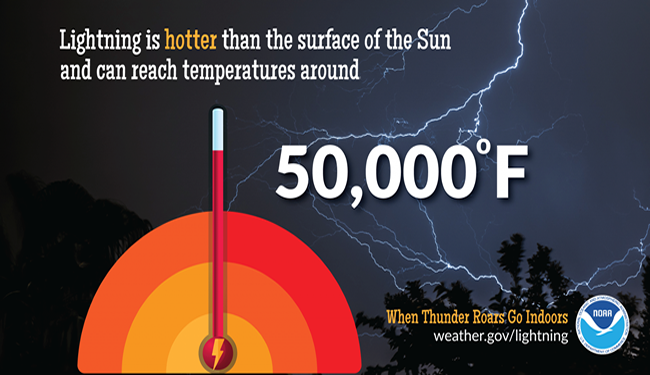As we go about our day, we occasionally see clouds darkening in the distance, we immediately think of rain headed in our direction. However, suddenly you see a quick flash of light ahead, a quick and sharp strike of a lightning bolt striking the ground. It is an all too familiar phenomena we have all experienced throughout our life. Lightning is a beautiful yet deadly and dangerous interaction with thunderstorms.
Lightning is one of the oldest observed phenomena on earth. However, it is a aspect of thunderstorms that are not very well understood. While lightning is simply a large spark of static electricity, scientists do not have a full understanding on how it works, or how it interacts with solar flares impacting the upper atmosphere or the earth's electromagnetic field. At any given moment, there can be as many as 2,000 thunderstorms occurring across the globe. This translates to more than 14.5 million storms each year.
How Is Lightning Created?
The certain conditions needed for lightning is something that scientist and researchers know and understand. However, exactly what causes the lightning is up for debate. Theories have found that separations of electric charges and generations of electric fields within a thunderstorm is what causes the lightning. There has also been correlation's found that ice, hail, and frozen water droplets are needed for lightning development.
 |
| Electric field within a thunderstorm |
The atmosphere is a very good insulator that inhibits electric flow, so a vast amount of charge has to build before lightning can occur. When that charge is reached, the strength of the electric field can overcome the atmosphere's insulating properties, thus lightning results.
The electric field within the storm is not the only one that develops. Below the negatively charged storm base, positive charge begins to pool within the surface of the earth (notice the image on the left).
This positive charge will shadow the storm wherever it goes, and is responsible for the all too familiar cloud-to-ground lightning strikes. However, the electric field within the storm is much stronger than the one between the storm and the earth's surface, this is why most lightning actual occurs inside the storm itself.
Sounds of Thunder
There is a common phrase within weather terms: "When the thunder roars, go in-doors!" This is a very wise statement, as thunder has a direct correlation with lightning.
 Thunder is the shock wave resulting from the extreme heat generated by lightning. Lightning can be as hot as 54,000°F, a temperature that is FIVE TIMES hotter than the surface of the sun! When lightning occurs, it heats the air surrounding itself to that same incredible temperature in a fraction of a second.
Thunder is the shock wave resulting from the extreme heat generated by lightning. Lightning can be as hot as 54,000°F, a temperature that is FIVE TIMES hotter than the surface of the sun! When lightning occurs, it heats the air surrounding itself to that same incredible temperature in a fraction of a second.Like all gases, when air molecules are heated, they expand. The faster they are heated up, the faster the rate of expansion. However, when air is heated to 54,000°F in a fraction of a second, a phenomenon known as "explosive expansion" occurs. This is where air expands so rapidly that it compresses the air in front of it, forming a shock wave similar to a sonic boom. Exploding fireworks produce a similar result.
Common Lightning Myths
There has been numerous myths created in reference to the nature of lightning. Just to clear the air, we figured in conclusion to this blog we would state a few. Some of the following are just a few of the common myths we've all heard before.
"We don't have to worry about that lightning, it's just heat lightning."
Heat lightning is one of the most misused weather terms during the summer season. Many people actually think that heat lightning is produced by hot and humid conditions. This is absolutely false, and there is no such thing as "heat lightning". The flashes of light that you are actually seeing is lightning, but the lightning is from a distant thunderstorm far enough from you where you cannot hear the thunder.
However, if you do witness lightning far enough away where you do not hear thunder, this does mean you can safely view it. This is due to the lightning being so far away!
"Don't worry, lightning never strikes the same place twice."
Lightning often strikes the same place repeatedly, especially if it's a tall, sharp, or isolated object. The Empire State Building is hit an average of 23 times a year. Also, if you've ever been on a boat in the ocean, or on a beach at night, you'll notice off-shore drilling rigs being struck several times.
"If you are in a house, you are 100% safe from lightning."
A house is a safe place to be during a thunderstorm as long as you avoid anything that conducts electricity. This means staying off corded phones, electrical appliances, wires, TV cables, computers, plumbing, metal doors and windows. Windows are hazardous for two reasons: wind generated during a thunderstorm can blow objects into the window, breaking it and causing glass to shatter and second, in older homes, in rare instances, lightning can come in cracks in the sides of windows.
"It's not raining outside, and I see no clouds overhead, I'm safe from lightning even though I can hear thunder."
Lightning often strikes more than three miles from the center of the thunderstorm, far outside the rain or thunderstorm cloud. “Bolts from the blue” can strike 10-15 miles from the thunderstorm.
We hope you've enjoyed this blog, and have learned some valuable information regarding lightning! Always remember, if you hear thunder roar - go indoors!
-Vortex Crew
Sources and imaged credits: https://www.weather.gov/ -





